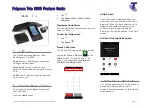
151
Before a phone model is available for sale to the
public, it must be tested and certified to the FCC
that it does not exceed the limit established by
the government-adopted requirement for safe
exposure. The tests are performed in positions
and locations (e.g., at the ear and worn on the
body) as required by the FCC for each model.
(Body-worn measurements differ among phone
models, depending upon available accessories
and FCC requirements). While there may be
differences between the SAR levels of various
phones and at various positions, they all meet
the government requirement.
For body worn operation, to maintain compliance
with FCC RF exposure guidelines, use only
approved accessories. When carrying the phone
while it is on, use the specific belt-clip that has
been tested for compliance.
Use of non-approved accessories may violate
FCC RF exposure guidelines and should be
avoided.
For additional information concerning exposure to
radio frequency signals, see the following
websites:
Federal Communications Commission
(FCC)
RF Safety program (select “Information on
Human Exposure to RF Fields from Cellular and
PCS Radio Transmitters”):
http://www.fcc.gov/oet/rfsafety
World Health Organization
(WHO)
International Commission on Non-Ionizing
Radiation Protection (select Qs & As):
http://www.who.int/emf
Reference Information
150
Reference Information
Radio Frequency (RF) Signals
Your mobile phone is a radio transmitter and
receiver. It is designed and manufactured not to
exceed the emission limits for exposure to radio
frequency (RF) energy set by the Federal
Communications Commission of the U.S.
Government. These limits are part of
comprehensive guidelines and establish permitted
levels of RF energy for the general population.
Those guidelines are consistent with the safety
standard previously set by both U.S. and
international standards bodies:
• American National Standards Institute (ANSI)
IEEE. C95.1-1992
• National Council on Radiation Protection and
Measurement (NCRP). Report 86
• International Commission on Non-Ionizing
Radiation Protection (ICNIRP) 1996
• Ministry of Health (Canada), Safety Code 6.
The exposure standard for wireless mobile
phones employs a unit of measurement known as
the Specific Absorption Rate, or SAR. The SAR
limit set by the FCC is 1.6W/kg.
Tests for SAR are conducted using standard
operating positions specified by the FCC with the
phone transmitting at its highest certified power
level in all tested frequency bands. Although the
SAR is determined at the highest certified power
level, the actual SAR level of the phone while
operation can be well below the maximum value.
This is because the phone is designed to operate
at multiple power levels so as to use only the
power required to reach the network. In general,
the closer you are to a wireless base station
antenna, the lower the power output.
Summary of Contents for EM201
Page 1: ...EM201 Owner s Manual ...







































